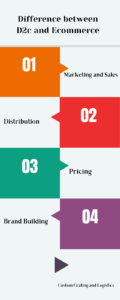In recent years, there has been a significant increase in the number of direct-to-consumer (D2C) and e-commerce businesses. Although both business models involve selling goods and services directly to consumers, they differ in their approach to marketing, sales, and distribution. We will explore the differences between D2C and e-commerce businesses in this article.

Definition of D2C and E-commerce:
D2C refers to a business model where manufacturers or producers sell their products directly to consumers, bypassing traditional retail channels. In this model, companies have complete control over product production, marketing, and distribution. E-commerce, on the other hand, refers to the buying and selling of products or services over the internet. E-commerce companies can be traditional brick-and-mortar stores that have expanded to sell online or online-only retailers.
Marketing and Sales:
D2C companies typically have a much stronger focus on building relationships with their customers. They do this by collecting data about their customers’ preferences and using it to tailor their products and marketing strategies. D2C companies often leverage social media platforms and influencer marketing to reach their target audience. D2C companies can gain valuable insights into their needs and preferences, allowing them to make better business decisions by creating a direct connection with their customers.
In D2C sales, the sales strategy provides a seamless and personalised customer experience. It involves creating a user-friendly website, optimising the checkout process, and providing excellent customer service. One of the main advantages of D2C sales is the ability to collect valuable customer data, which improves the sales process and provides customers with a better experience.
One of the main challenges of D2C sales is the need to build trust. Since customers buy directly from the brand, they need to trust the brand to deliver quality products and services. It can be achieved through transparency, providing customer reviews and feedback, and offering guarantees and warranties.
E-commerce companies, on the other hand, tend to rely more on traditional marketing and advertising methods, such as search engine optimization (SEO) and pay-per-click (PPC) advertising. While they may collect data, their focus is driving traffic to their website and converting those visitors into customers.
One of the advantages of e-commerce marketing is the ability to leverage the platform’s existing customer base. Since many e-commerce platforms have a large and active customer base, businesses can tap into this audience to reach new customers and drive sales.
Another crucial aspect of e-commerce marketing is the need to optimize product listings. It involves creating compelling product descriptions and high-quality images and optimizing keywords to improve search rankings. By optimizing product listings, businesses can increase their visibility and drive more traffic to their store.
A successful sales strategy in e-commerce requires a holistic approach encompassing all aspects of the customer journey, from marketing to customer service. By knowing your audience, building a huge brand, optimizing your website, investing in SEO, leveraging social media, offering excellent customer service, and using data to inform your strategy, you can set your e-commerce business up for long-term success.
 Distribution:
Distribution:
D2C companies have complete control over their distribution channels. They are responsible for shipping their products directly to their customers, which allows them to provide a faster and more personalized experience. Many D2C companies have also adopted a subscription-based model, where customers receive products regularly, further strengthening the relationship between the company and its customers. E-commerce companies may also have control over their distribution channels, but they often rely on third-party logistics (3PL) companies to handle the shipping and delivery of their products. It can result in a longer delivery time and a less personalized experience for the customer.
A successful sales strategy in e-commerce requires a holistic approach encompassing all aspects of the customer journey, from marketing to customer service. By knowing your audience, building a good brand, optimizing your website, investing in SEO, leveraging social media, offering excellent customer service, and using data to inform your strategy, you can set your e-commerce business up for long-term success.
Pricing:
D2C companies often offer their products at a lower price than traditional retailers because they bypass the middleman. D2C companies can offer their products at a lower cost while maintaining a healthy profit margin by eliminating the markup that retailers typically add to the product’s price
E-commerce companies may also offer competitive pricing but often face stiff competition from other online retailers. It can make it more challenging for e-commerce companies to maintain a profitable business model at low prices.
Brand Building:
D2C companies place a strong emphasis on building their brand. By creating a direct connection with their customers and offering a personalized experience, D2C companies can make a loyal following. Many D2C companies have also adopted a socially responsible approach to business, which can help to strengthen their brand and create a positive reputation.

E-commerce companies also place an impact on building their brand, but their approach is often more focused on building a high online presence. By leveraging social media and search engine optimization, e-commerce companies can increase their visibility and attract new customers.
One of the main pricing differences between e-commerce and D2C is the cost of goods sold (COGS). COGS refers to the direct costs of producing or acquiring the products that a business sells. In e-commerce, sellers often source their products from wholesalers or manufacturers and must pay a wholesale price for each unit they purchase. It means that e-commerce sellers must factor in the wholesale cost when pricing their products, which can limit their ability to set lower prices.
In contrast, D2C brands often have more control over their COGS because they produce their products in-house or work directly with manufacturers. It means that D2C brands can often make their products at a lower cost than e-commerce sellers, allowing them to set lower prices for products.
Another factor contributing to the pricing difference between e-commerce and D2C is the marketing and advertising costs. E-commerce sellers must compete with other sellers on the platform to attract buyers to their products. It often requires them to invest in marketing and advertising campaigns to increase their visibility. These campaigns can be expensive, and sellers must factor in the marketing and advertising costs when pricing their products.
In contrast, D2C brands can often rely on word-of-mouth marketing and social media to promote their products. It can be a more cost-effective marketing approach, allowing D2C brands to set lower prices for their products.
D2C brands also have more control over their branding and customer experience, which can be another factor that contributes to the pricing difference between e-commerce and D2C. D2C brands can create a unique brand identity and control every aspect of the customer experience, from the website design to the packaging and shipping. It can help D2C brands build customer loyalty and charge premium prices for their items.
In contrast, e-commerce sellers often have less control over the branding and customer experience. They must conform to the guidelines of the platform and may not create a unique brand identity. It can limit their ability to charge premium prices for their products.
Conclusion:
In summary, D2C and e-commerce businesses are a process of selling products or services directly to consumers. However, their approach to marketing, sales, distribution, pricing, and brand building does vary. D2C companies typically focus on building a connection with their customers, and e-commerce companies rely more on traditional marketing methods. D2C companies have complete control over their distribution channels, while e-commerce companies may rely on third-party logistics providers
Not sure which solution fits your business needs?
Call now at +1 (847) 258-5530

